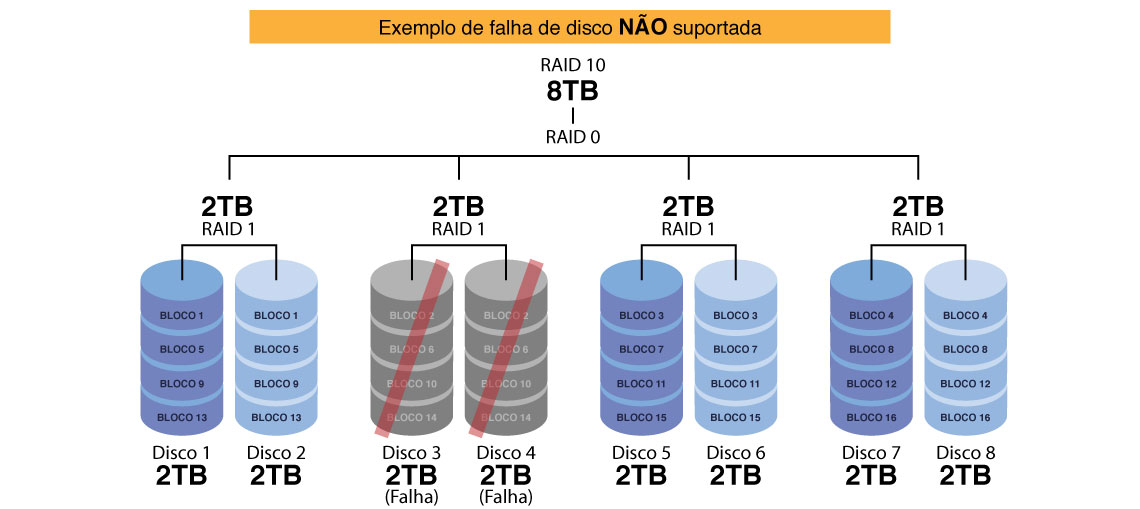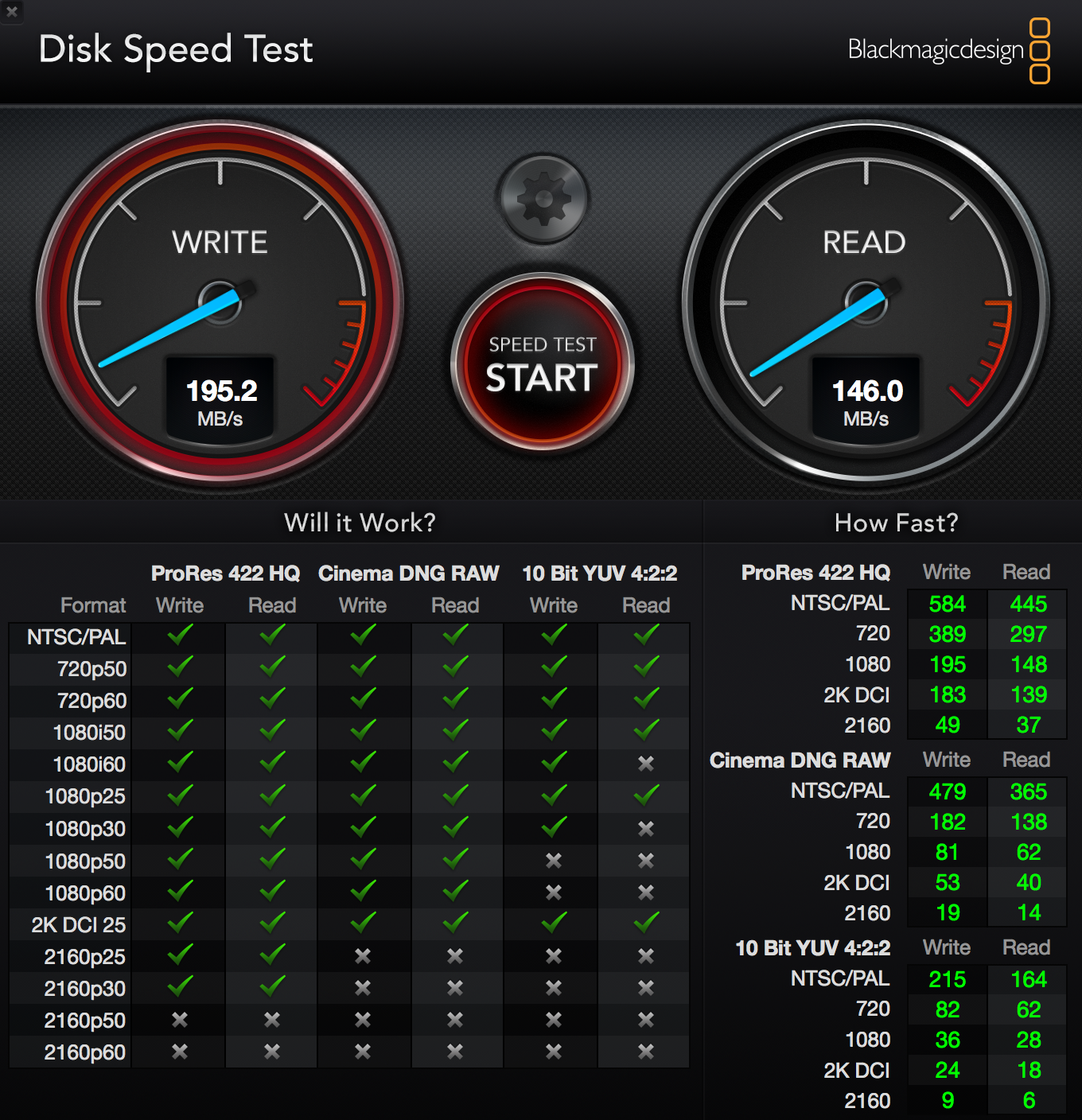Summary
When you lost precious RAID 1 data, don't panic. Let professional RAID 1 recovery software help you restore lost RAID 1 disk data. EaseUS RAID recovery software can always recover deleted, formatted or lost data with simple steps. Get this software and get back lost RAID data.
Create a disk set using Disk Utility on Mac. You can create a Redundant Array of Independent Disks (RAID) set to optimize storage performance and increase reliability in case of a disk failure. You can also create a set that concatenates smaller disks to act as one larger disk. Launch EaseUS data recovery software, select the Raid 1 drive where you want to recover data. SoftRAID allows you to create and manage disk arrays to increase performance and reliability. SoftRAID allows the user to create and manage RAID 4 and 5 volumes, RAID 1+0, and RAID 1 (Mirror) and RAID 0 (Stripe) volumes. SoftRAID also provides 'predictive disk failure', where users are alerted to potential disk failures even before they fail. RAID 10 combines mirrors (RAID 1) with stripes (RAID 0) for a fast yet redundant array. The end result is that RAID 10 is speedy (because data is written to multiple drives) and redundant (because. We do also provide hardware RAID controllers for the Mac Pro 5,1 at Create Pro. Complete with on board battery and controller for extra security. Follow @createpro Tweet. 24th February 2015. Previous Article. ManvsMachine Motion Designer Ollie Harris Q&A: 3D, Live Action Shooting, Design Approach and more.
- Recover RAID 1 Data for Windows
- RAID 1 Data Recovery for Mac
Everything About RAID 1
RAID 1 refers to an exact copy (or mirror) of a set of data on two or more disks. According to Wikipedia, it seems that the RAID 1 configuration provides parity, striping or spanning of disk space across multiple disks. This is useful when read performance or reliability is more important than data storage capacity. RAID 1 writes two copies of the data simultaneously on two separate drives. This is called a fault-tolerant. When one of the mirrored drives suffers a mechanical failure such as spindle failure or does not respond, the remaining drives will continue to function. The RAID 1 configuration is performed either by a hardware RAID controller or performed in software. It is suited to applications requiring high fault tolerance at a low cost and where a duplicated set of data is more secure than using parity. RAID 1 is popular for accounting and other financial data. It is also commonly used for small database systems, enterprise servers, and home PCs where fairly inexpensive fault tolerance is required.
Advantages
- Fast speed. RAID 1 offers an excellent read-and-write speed that is comparable to that of a single drive.
- Large storage. It’s known that RAID arrays usually consist of two or more disks. RAID 1 has much more storage space than a single drive.
- Continuous system running. On a computer that contains only one hard drive, if the drive fails, the operating system will stop at once. However, in a RAID array, if a hard disk fails, the system will be able to keep running normally for a certain time.
Disadvantages
- The effective storage capacity is only half of the total drive capacity because all data get written twice.
- The failed drive can only be replaced after powering down the computer it is attached to. For servers that are used simultaneously by many people, this may not be acceptable. Such systems typically use hardware controllers that do support hot-swapping.
Why You Lost RAID 1 Data
Although it seems that RAID 1 disk can be an ideal tool for storing and backing up data with a high fault-tolerant feature. But when data loss issues happen to the RAID 1 disk or RAID 1 volume, what can you do? Here the following are some major reasons for RAID 1 data loss issues:
- 1. RAID 1 disk failure
- 2. RAID 1 disk rebuild
- 3. Format RAID 1
- Notice:
- If the RAID 1 drive got physical damaged or the RAID 1 drive controller got broken, you'll not be able to get lost data back then.
So how to restore RAID 1 data? When you lost important RAID 1 data in Windows 10/8/7, stop using it immediately. Ane let professional RAID 1 data recovery software to help.
Download RAID 1 Recovery Software for Help
EaseUS Data Recovery Wizard is a professional RAID 1 recovery program. It recovers data when you encounter partition loss or damage, software crash, virus infection, unexpected shutdown or any other unknown issues. It provides the comprehensive RAID 1 recovery solution for computer users to recover data from RAID 1. If you lost RAID 1 data are less than 2GB, let free data recovery software help you now. If lost RAID 1 data is over 2GB, then you'll need EaseUS Data Recovery Wizard Pro for help. Moreover, this RAID 1 recovery software works well with dynamic disk, RAID and EXT2/EXT3 file system.
Most importantly, it can recover lost files with their original file names and storage paths - which other apps cannot do. It also works as a hard drive recovery tool from EaseUS to rescue your files and save you money!
- 1. Unformat the drive
- 2. Repair the RAID, RAW disk or operating system
- 3. Recover lost partition (the one that cannot be recovered by software)
Steps to Recover RAID 1 Data with RAID 1 Data Recovery Software (for Win)
Step 1. Run EaseUS Data Recovery Wizard and scan the RAID drive.
Choose the RAID drive from where you wish to recover data, and then click 'Scan'. Wait for some time, the deleted files will appear one after another.
Step 2. Find and preview lost RAID drive files.
Find the lost Raid drive files from 'Deleted Files', 'Lost Files' or you can use Filter as quick navigation to find all lost files. Besides, you can also use Search to find your lost Raid drive files via its file name or file extension.
Step 3. Restore lost RAID drive files.
Double-click to check and preview the found files, select these files and click 'Recover' to save them. Browse to save these files to another secure location, click 'OK' to confirm.
Why not download this raid 1 recovery software to experience the magic recovery functions now.
RAID 1 Data Recovery for Mac
If you lost RAID 1 data on Mac, what can you do? Finding Mac RAID 1 recovery software is usually more difficult than finding software for Windows. In fact, EaseUS can also help. RAID is composed of multiple disks. If the RAID structure is intact, you will be able to recover data from the virtual disk created on the RAID with EaseUS Mac data recovery software.

Step 1. Select the disk location (it can be an internal HDD/SSD or a removable storage device) where you lost data and files. Click the Scan button.
Step 2. EaseUS Data Recovery Wizard for Mac will immediately scan your selected disk volume and display the scanning results on the left pane.
Step 3. In the scan results, select the file(s) and click Recover Now button to have them back.
People Also Ask
1. What is RAID recovery?
RAID recovery is the process of data recovery from a RAID array which failed for whatever reason. WaseUS data recovery software is a powerful data recovery tool that can successfully recover RAID data.
2. Can a RAID 1 disk be read on its own?
Yes, most RAID 1 systems create disks that are readable separately when connected to a non-RAID controller.
3. What is the difference between RAID 0 and RAID 1?
RAID 0 consists of striping, but no mirroring or parity. RAID 1 consists of data mirroring, without parity or striping.
4. Can RAID 1 have more than 2 drives?
Best Raid 1 Nas For Mac
Yes, a minimum of two disks is required for RAID 1 hardware implementations. With software RAID 1, instead of two physical disks, data can be mirrored between volumes on a single disk.
Many people use the RAID 1 array for storing financial data and small database systems. It is a convenient way to store databases that need parity to function better.

RAID is not about data backup, but about volume redundancy on disks. RAID mirrors data and uses the architecture of RAID to write information on disks simultaneously. Recovery is complicated for those who are not computer professionals. If you are not sure about your skills, don’t try to restore data manually. In this case, you should follow the instructions provided below.
What is RAID 1 Array?
RAID 1 consists of a copy, or a mirror, of data on two or more disks. A classic RAID 1 pair offers no parity, spanning or striping of disk space across multiple disks. Since data is mirrored on all disks belonging to an array, an array can be as large as the smallest member disk. This layout is useful if read performance is more essential than write performance or resulting data storage capacity.
RAID 1 provides you with good fault tolerance and is simpler than RAID 1-0.
To provide fault tolerance, RAID 1 writes the same data twice on two separate drives. This process is called a data mirroring. If one drive is mechanically broken or data is corrupted, the rest of the drives will function and keep all the data anyway. But functioning can be performed with some mistakes. That’s why if you have any mistakes or if you have mechanically broken one of the disks, start the data recovery process as soon as possible.
RAID 1 is suitable in cases where you need extra reliability. To increase the speed of reading data, you should use our RAID configuration.
How to recover lost RAID 1 data with software?
If data was lost because of a system fault or hard drive failure, use RAID Recovery by Diskinternals. The recovery process will be handled by sophisticated software algorithms.
There are two common ways to handle RAID 1 recovery. The first approach is:
- 1. Pull the disks out from the NAS.
- 2. Connect them to your computer.
- 3. Open the largest EXT partition in the Linux reader.
- 4. If that didn't work, use the Linux recovery.
If you want to make the recovery process easier, download, install and run RAID Recovery on your computer. As a first step, scanning will be performed. The software will discover if restoring the data is possible.
If the result is positive, congratulations, your data can be restored almost instantly! Please check your files in preview mode to ensure you get what is necessary. If you have any pictures to restore, it would be helpful to check their integrity.
Raid 1 For Mac High Sierra
Afterwards, purchase the license online and continue the RAID 1 Recovery process. The information will be restored and transferred to another place automatically.
Data Recovery RAID 1 for Windows
The RAID 1 recovery for Windows is pretty simple because software for Windows is used commonly. To download the licensed version, simply choose your Windows version and the software will be adapted to it appropriately.
You can download the software from the Diskinternals website to handle the RAID 1 recovery simply. It might take less than a couple of minutes.
Afterwards, the data recovery RAID 1 will proceed. You will need at least some free volume to keep recovered data from the corrupted array. It might take some time, depending on the volume of your array, but don’t worry, the software will restore all possible data.
If the array structure is corrupted, the file system usually performs correctly. If the problem is an array structure corruption, there is no need to scan all the disks, and you can save some time by opening an array in Reader or Uneraser mode. This usually takes up to five minutes, instead of a couple of hours of total disk scanning.
The RAID Recovery by DiskInternals works with all RAID types by connecting the array elements as couple of single disks. The recovery process is performed without the controller or array transferring. If you need it, the disk image can be recovered to be saved elsewhere.
Data Recovery RAID 1 for Mac
Finding RAID 1 recovery software for Mac is usually more difficult than finding software with the same functionalities for Windows. The same is true about any data recovery software, but Diskinternals company has some good news for you! The Diskinternals company makes the process of data recovery on the Mac as simple as the same process on Windows. To perform the recovery, you should follow this simple guide.
To recover data from RAID 1 drive, download the Diskinternals RAID Recovery software right from the website, use Parallels Desktop or any other Windows emulator. Then perform the installation process, which has its own step-by-step instructions. All you need to do is simply follow them.
The software will scan your disks and display if the recovery is possible. If the result is positive, you are free to continue. After scanning is completed and you see the results, you can start to recover RAID 1 data.
Your files will be saved and then you can move them to anywhere you want. It can be a local disk, a network disk, or an FTP connection. As in Windows, you will need the same number of independent disks that the corrupted array had. If you experience any troubles during the RAID 1 failure recovery, call the customer care department.
RAID 1 Hard Drive Recovery Steps
Here is a step-by-step guide for you. To recover your data, simply follow the RAID 1 recovery steps below.
- 1. Connect the array disks to your computer as independent local disks.
- 2. Launch the Diskinternals RAID recovery software.
- 3. Open and perform the RAID Wizard. The new RAID disk will be added to the disk list.
- 4. In Reader or Uneraser mode, open the logical disk contained in the Hard Drives section of the disk list from the RAID disk.
- 5. Highlight the data and save it to some new place using the Saving Wizard.

If you experience any issues or difficulties with the recovery process, feel free to contact our customer care team. Our plans differ by the quantity of supported disks and the possibility to support RAID 6. Free software supports two disks only. RAID Recovery software supports all vendors, including QNAP RAID 1 recovery. Choose the plan you find appropriate and forget about any difficulties during the data recovery process!
